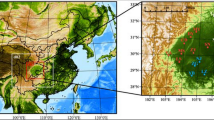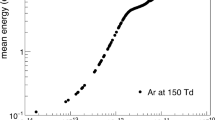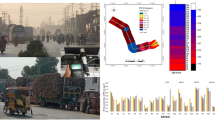Abstract
The Euler–Lagrangian method is adopted to simulate the dispersion of gaseous pollutants and particulate matter (PM) in isolated street canyons, and the influences of the roof angle on the flow structures and distributions of gaseous pollutants and PM are analyzed in detail. Numerical simulation results indicate that gaseous pollutants and PM in the canyons present three typical single main clockwise vortex, transition vortex, and double vortex structures, which are identified at increasing roof slopes. Gaseous pollutants and PM demonstrate the lowest concentration of pollutants when a single vortex structure exists. The concentration of gaseous pollutants and PM reaches the highest value in pedestrian-level areas when the flow field is in a transitional vortex structure. Unlike gaseous pollutants, the concentration of PM does not always decrease with increasing altitude, and higher PM concentrations sometimes occur in the mid-level areas of the canyon. A small roof incline angle is generally recommended for discharging gaseous pollutants and PM.













Similar content being viewed by others
Data availability
The datasets used and/or analyzed during the current study are available from the corresponding author on reasonable request.
Abbreviations
- C α :
-
Pollutant concentration (kg/m3)
- D α :
-
Pollutant molecular diffusion rate (kg/s)
- d p :
-
Particle diameter (m)
- \( \overrightarrow{F} \) :
-
Additional force (N)
- H :
-
Building height (mm)
- K :
-
Dimensionless concentration
- m p :
-
Particle mass (kg)
- \( \overline{P} \) :
-
Dynamic pressure (pa)
- Q :
-
Pollutant release rate (kg/s)
- Re:
-
Reynolds number
- \( {\overline{S}}_i \) :
-
The source term of the momentum equation caused by particle matter
- Sc t :
-
Turbulent Schmidt number
- \( {\overline{u}}_H \) :
-
Inlet velocity (m/s)
- \( {\overline{u}}_i \) :
-
Time-averaged velocity components, (m/s)
- \( {u}_i^{\hbox{'}} \) :
-
Pulsation velocities (m/s)
- \( \overline{u_i^{\hbox{'}}{u}_j^{\hbox{'}}} \) :
-
Reynolds stresses (N)
- u p :
-
Particle velocity (m/s)
- W :
-
Street canyon width (mm)
- W b :
-
Pollution source width (mm)
- β :
-
Triangular roof angle (°)
- α :
-
Wind profile index
- ρ :
-
Fluid density (kg/m3)
- ν :
-
Air kinematic viscosity (m2/s)
- ∇:
-
Definition operator
- δ ij :
-
Kronecker delta symbol
- ν T :
-
Kinematic eddy (turbulent) viscosity (m2/s)
- κ :
-
The turbulent kinetic energy (J)
- ε :
-
Turbulence kinetic energy dissipation rate
- ρ p :
-
Particle density (kg/m3)
- τ r :
-
Particle relaxation time (s)
- μ :
-
Molecular viscosity of the continuous phase
References
Allegrini J (2018) A wind tunnel study on three-dimensional buoyant flows in street canyons with different roof shapes and building lengths. Build Environ 143:71–88
Allegrini J, Dorer V, Carmeliet J (2014) Buoyant flows in street canyons: validation of CFD simulations with wind tunnel measurements. Build Environ 72:63–74
Chan CK, Yao XH (2008) Air pollution in mega cities in China. Atmos Environ 42:1–42
Chew LW, Norford LK (2018) Pedestrian-level wind speed enhancement in urban street canyons with void decks. Build Environ 146:64–76
Dechezleprêtre A, Neumayer E, Perkins R (2015) Environmental regulation and the cross-border diffusion of new technology: evidence from automobile patents. Res Po 44:244–257
Ding S, Huang YD, Cui PY, Wu J, Li MZ, Liu DT (2019) Impact of viaduct on flow reversion and pollutant dispersion in 2D urban street canyon with different roof shapes - numerical simulation and wind tunnel experiment. Sci Total Environ 671:976–991
Gromke C, Blocken B (2015) Influence of avenue-trees on air quality at the urban neighborhood scale. Part I: quality assurance studies and turbulent Schmidt number analysis for RANS CFD simulations. Environ Pollut 196:214–223
Habilomatis G, Chaloulakou A (2015) A CFD modeling study in an urban street canyon for ultrafine particles and population exposure: the intake fraction approach. Sci Total Environ 530-531:227–232
Hang J, Lin M, Wong DC, Wang XM, Wang BM, Buccolieri R (2016) On the influence of viaduct and ground heating on pollutant dispersion in 2D street canyons and toward single-sided ventilated buildings. Atmos Pollut Res 7:817–832
Hang J, Luo ZW, Wang XM, He LJ, Wang BM, Zhu W (2017) The influence of street layouts and viaduct settings on daily CO exposure and intake fraction in idealized urban canyons. Environ Pollut 220:72–86
Hang J, **an ZN, Wang DY, Mak CM, Wang BM, Fan YF (2018) The impacts of viaduct settings and street aspect ratios on personal intake fraction in three-dimensional urban-like geometries. Build Environ 143:138–162
Hao CR, **e XM, Huang Y, Huang Z (2019) Study on influence of viaduct and noise barriers on the particulate matter dispersion in street canyons by CFD modeling. Atmos Pollut Res 10:1723–1735
He LJ, Hang J, Wang XM, Lin BR, Li XH, Lan GD (2017) Numerical investigations of flow and passive pollutant exposure in high-rise deep street canyons with various street aspect ratios and viaduct settings. Sci Total Environ 584–585:189–206
Hendryx M, Luo JH, Chojenta C, Byles JE (2019) Air pollution exposures from multiple point sources and risk of incident chronic obstructive pulmonary disease (COPD) and asthma. Environ Res 179:108783
Hua LH, Zhang XC, Zhu W, Ning Z, Tang F (2015) A global relation of fire smoke re-circulation behaviour in urban street canyons. J Civ Eeg Manag 21(4):459–469
Huang H, Akutsu Y, Arai M, Tamura M (2000) A two-dimensional air quality model in an urban street canyon: evaluation and sensitivity analysis. Atmos Environ 34:689–698
Huang YD, ** MX, Sun YN (2007) Numerical studies on airflow and pollutant dispersion in urban street canyons formed by slanted roof buildings. Ser B 19(1):100–106
Huang YD, Hu XN, Zeng NB (2009) Impact of wedge-shaped roofs on airflow and pollutant dispersion inside urban street canyons. Build Environ 44:2335–2347
Huang YD, He WR, Kim CN (2015) Impacts of shape and height of upstream roof on airflow and pollutant dispersion inside an urban street canyon. Environ Sci Pollut Res 22:2117–2137
Huang YD, Zeng NB, Liu ZY, Song Y, Xu X (2016a) Wind tunnel simulation of pollutant dispersion inside street canyons with galleries and multi-level flat roofs. J Hydrodyn 28(5):801–810
Huang YD, Xu X, Liu ZY, Deng JT, Kim CN (2016b) Impacts of shape and height of building roof on airflow and pollutant dispersion inside an isolated street canyon. Environ Forensic 17(4):361–379
Iwai K, Mizuno S, Miyasaka Y, Mori T (2005) Correlation between suspended particles in the environmental air and causes of disease among inhabitants: cross-sectional studies using the vital statistics and air pollution data in Japan. Environ Res 99:106–117
Li XX, Liu CH, Leung DYC (2008) Large-eddy simulation of flow and pollutant dispersion in high-aspect-ratio urban street canyons with wall model. Bound-Layer Meteorol 129:249–268
Li XX, Liu CH, Leung DYC (2009) Numerical investigation of pollutant transport characteristics inside deep urban street canyons. Atmos Environ 43:2410–2418
Lien FS, Yee E, Cheng Y (2004) Simulation of mean flow and turbulence over a 2D building array using high-resolution CFD and a distributed drag force approach. J Wind Eng Ind Aerodyn 92:117–158
Liu XP, Niu JL, Kwok KCS, Wang JH, Li BZ (2010) Investigation of indoor air pollutant dispersion and cross-contamination around a typical high-rise residential building: Wind tunnel tests. Build Environ 45:1769–1778
Lu L, Luo T, Zhao Y, Cai CH, Fu ZW, ** YX (2019) Interaction between microplastics and microorganism as well as gut microbiota: a consideration on environmental animal and human health. Sci Total Environ 66:794–100
Madalozzo DMS, Braun AL, Awruch AM, Morsch IB (2014) Numerical simulation of pollutant dispersion in street canyons: geometric and thermal effects. Appl Math Model 38:5883–5909
Meroney RN, Pavageau M, Rafailidis S, Schatzmann M (1996) Study of line source characteristics for 2-D physical modeling of pollutant dispersion in street canyons. J Wind Eng Ind Aerodyn 62:37–56
Moonen P, Gromke C, Dorer V (2013) Performance assessment of large eddy simulation (LES) for modeling dispersion in an urban street canyon with tree planting. Atmos Environ 75:66–76
Morakinyo TE, Lam YF (2016) Simulation study on the impact of tree-configuration, planting pattern and wind condition on street-canyon’s micro-climate and thermal comfort. Build Environ 103:262–275
Ng WY, Chau CK (2014) A modeling investigation of the impact of street and building configurations on personal air pollutant exposure in isolated deep urban canyons. Sci Total Environ 468–469:429–448
Prakash S, Prabhahar M, Sendilvelan S, Venkatesh R, Singh S, Bhaskar K (2019) Experimental studies on the performance and emission characteristics of an automobile engine fueled with fish oil methyl ester to reduce environmental pollution. Energy Procedia 160:412–419
Price HD, Arthur R, BeruBe KA, Jones TP (2014) Linking particle number concentration (PNC), meteorology and traffic variables in a UK street canyon. Atmos Res 147:133–144
Quang TN, He C, Morawska L, Knibbs LD, Falk M (2012) Vertical particle concentration profiles around urban office buildings. Atmos Chem Phys 12:5017–5030
Ramponi R, Blocken B, Coo LB, Janssen WD (2015) CFD simulation of outdoor ventilation of generic urban configurations with different urban densities and equal and unequal street widths. Build Environ 92:152–166
Sun D, Zhang Y (2018) Influence of a venue trees on traffic pollutant dispersion in asymmetric street canyons: numerical modeling with empirical analysis. Transport Res D-TR 65:784–795
Tagaris E, Liao KJ, Delucia AJ, Deck L, Amar P, Russell AG (2009) Potential impact of climate change on air pollution-related human health effects. Environ Sci Technol 43:4979–4988
Takano Y, Moonen P (2013) On the influence of roof shape on flow and dispersion in an urban street canyon. J Wind Eng Ind Aerodyn 123:107–120
Tominaga Y, Stathopoulo T (2009) Numerical simulation of dispersion around an isolated cubic building: comparison of various types of k–ɛ models. Atmos Environ 43:3200–3210
Wang XX, Li YG (2016) Predicting urban heat island circulation using CFD. Build Environ 99:82–97
Wang J, Cao H, Sun DQ, Qi ZF, Guo CY, Peng WJ, Sun YY, **e YY, Liu XH, Li BX, Luo YX, Pan Y, Li YC, Zhang L (2019a) Associations between ambient air pollution and mortality from all causes, pneumonia, and congenital heart diseases among children aged under 5years in Bei**g, China: a population-based time series study. Environ Res 176:108531
Wang Q, Zhou TT, Liu Q, He PX, Tao CF, Shi Q (2019b) Numerical study of critical re-entrainment velocity of fire smoke within the street canyons with different building height ratios. Environ Sci Pollut R 26:23319–23327
Wen H, Malki-Epshtein L (2018) A parametric study of the effect of roof height and morphology on air pollution dispersion in street canyons. J Wind Eng Ind Aerodyn 175:328–341
Yang F, Zhong K, Chen YH, Kang YM (2017) Simulations of the impacts of building height layout on air quality in natural-ventilated rooms around street canyons. Environ Sci Pollut Res 24:23620–23635
Yassin MF (2011) Impact of height and shape of building roof on air quality in urban street canyons. Atmos Environ 45:5220–5229
Yassin MF (2013) Numerical modeling on air quality in an urban environment with changes of the aspect ratio and wind direction. Environ Sci Pollut Res 20:3975–3988
Zhang YW, Gu Z, Lee SC, Fu TM, Ho KF (2011) Numerical simulation and in situ investigation of fine particle dispersion in an actual deep street canyon in Hong Kong. Indoor Built Environ 20:206–216
Zhang M, Liu XX, Ding YT, Wang WW (2019a) How does environmental regulation affect haze pollution governance?—an empirical test based on Chinese provincial panel data. Sci Total Environ 695:133905
Zhang XC, Zhang ZJ, Su GK, Tao HW, Xu WH, Hu LH (2019b) Buoyant wind-driven pollutant dispersion and recirculation behavior in wedge-shaped roof urban street canyons. Environ Sci Pollut Res 26:8289–8302
Zhao CN, Xu ZW, Wu GC, Mao YM, Liu LN, Wu Q, Dan YL, Tao SS, Zhang Q, Sam NB, Fan YG, Zou YF, Ye DQ, Pan HF (2019) Emerging role of air pollution in autoimmune diseases. Autoimmun Rev 18:607–614
Zhi HN, Qiu ZW, Wang WZ, Wang G, Hao YZ, Liu YL (2020) The influence of a viaduct on PM dispersion in a typical street: field experiment and numerical simulations. Atmos Pollut Res 11:815–824
Funding
The work was financially supported by the National Natural Science Foundation of China (Nos. U1933131 and 51906055), the Fundamental Research Funds for the Central Universities (No. PA2020GDKC0017), and the China Postdoctoral Science Foundation (No. 2018M640582)
Author information
Authors and Affiliations
Contributions
All authors contributed to the study conception and design. Programming, data collection, and analysis were performed by **aoxiao Zhang, Taotao Zhou, and Changfa Tao. The first draft of the manuscript was written by **aoxiao Zhang, and all authors commented on previous versions of the manuscript. All authors read and approved the final manuscript.
Corresponding authors
Ethics declarations
Conflicts of interests
The authors declare that they have no competing interests.
Ethics approval and consent to participate
Not applicable.
Consent for publication
Not applicable.
Additional information
Responsible Editor: Marcus Schulz
Publisher’s note
Springer Nature remains neutral with regard to jurisdictional claims in published maps and institutional affiliations.
Rights and permissions
About this article
Cite this article
Zhang, X., Wang, C., Liu, X. et al. Effect of triangular roof angle on dispersion of gaseous pollutants and particulate matter. Environ Sci Pollut Res 28, 15537–15550 (2021). https://doi.org/10.1007/s11356-020-11512-6
Received:
Accepted:
Published:
Issue Date:
DOI: https://doi.org/10.1007/s11356-020-11512-6




